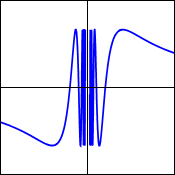A continuous graph is a predictable, the graph will go where its intended to go. The graph has no jumps, holes or brakes. You can also draw this graph without lifting your pencil. As seen in the picture below.

A discontinuity is something that stops the graph from being continuous. There are four types of discontinuities. There are point discontinuities that when graphed it still reaches the intended point but it has no value(this is a removable discontinuity). These next three are non removable discontinuities. There are jump discontinuities which is where the limit reached two different points leaving a gap that looks like a jump. There are infinite discontinuities. These occur when there is a vertical asymptote which results in unbounded behavior, making the graph go towards infinity. and the last one is oscillating discontinuity, this graph just looks very wiggly. The reason why this is a discontinuity is because the graph doesn't know where it wants to go.

here we see how a jump discontinuity looks then we see two holes and finally we see and infinite discontinuity

This is an oscillating discontinuity
2. What is a limit? When does a limit exist? When does a limit not exist? What is the difference between a limit and a value
the definition of a limit is the intended height of a function. The limit exists whenever both the left side of the function and the right side of the function meet. a limit does not exist in the non removable discontinuities because both sides of the graph do not get to the intended height.
like said before, the limit is the intended height of the function, that does not mean that the point will always be there. the value is the actual number or the actual height that the graph reached.
3. How do we evaluate limits numerically, graphically, and algebraically?
You can evaluate limits numerically using and using the closes values to the number.
You evaluate the limits graphically by using the graph and with two different points you make those two points meet. if they meet then that's the limit, if they do not meet then the limit does not exist.
algebraically. there are different methods to evaluate a graph algebraically. The firs one is substitution, on here all you have to do is plug in the number and solve. this can give you four different answers. a number, 0, undefined, or indeterminate. if you get that last one then you have to try the other methods, if not, you're done with the problem. The other method is the factoring/divide method. Here you look to factor the function in order to find something to cancel. then after canceling then you try substitution again. the last method is the rationalizing/conjugate method. Here you use the factor with the radical sign and you rationalize it in order to be able to cancel some stuff out and then you can try substitution again.
Works cited
http://images.tutorcircle.com/cms/images/tcimages/types-of-discontinuity-in-calculus-functions-1330067235.jpg
http://www.milefoot.com/math/calculus/limits/images/oscdisc.gif
http://www.milefoot.com/math/calculus/limits/images/oscdisc.gif
No comments:
Post a Comment